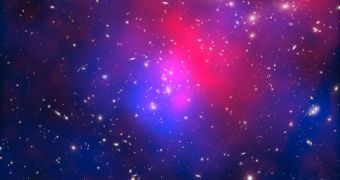One of the most interesting implications of Albert Einstein's theory of general relativity has been demonstrated in a new study. Experts managed to confirm that light indeed travels from distant clusters in the manner implied by this fundamental building block of modern physics.
Interestingly enough, while the new results do confirm Einstein was correct, they do not imply that an alternative theory of gravity currently receiving much attention in the international astronomical community is incorrect.
The other set of proposals was developed in order to circumvent the need for considering dark energy as playing any role in the Universe. Dark energy is a measure invented so that astrophysicists can explain the ever-accelerating expansion of the Cosmos.
The effect recently demonstrated is called gravitational redshift. Einstein proposed that the wavelengths of light emitted from very distant galaxies – which developed shortly after the Big Bang – is shifted ever so slight as it travels through space, in relation to the mass of the galaxy and the traveled distance.
In order to confirm the discoveries, experts had to analyze photon streams emitted by hundreds of thousands of galaxies. There are three main types of redshifts, one caused by galactic mass, the second one by galactic movement, and the third one by the expansion of the Universe.
Galactic redshift is the smallest of the three, and this is the main reason why experts found it so difficult to verify it for certain until now. All the galaxies surveyed for the new analysis were a part of the Sloan Digital Sky Survey (SDSS), Space reports.
During the investigation, the study team learned that the old predictions Einstein made are in exact agreement with the observed realities. The University of Copenhagen research group was led by astrophysicist Radoslaw Wojtak.
“We have independent measurements of the cluster masses, so we can calculate what the expectation for gravitational redshift based on general relativity is. It agrees exactly with the measurements of this effect,” the team leader explains.
“This is the only general relativistic effect which has been observed and confirmed locally on the Earth and on the scale corresponding to the universe. We have a link between our local scale of the Earth and galaxy clusters,” he concludes.
Details of the new investigation are published in the September 29 issue of the top scientific journal Nature.

 14 DAY TRIAL //
14 DAY TRIAL //